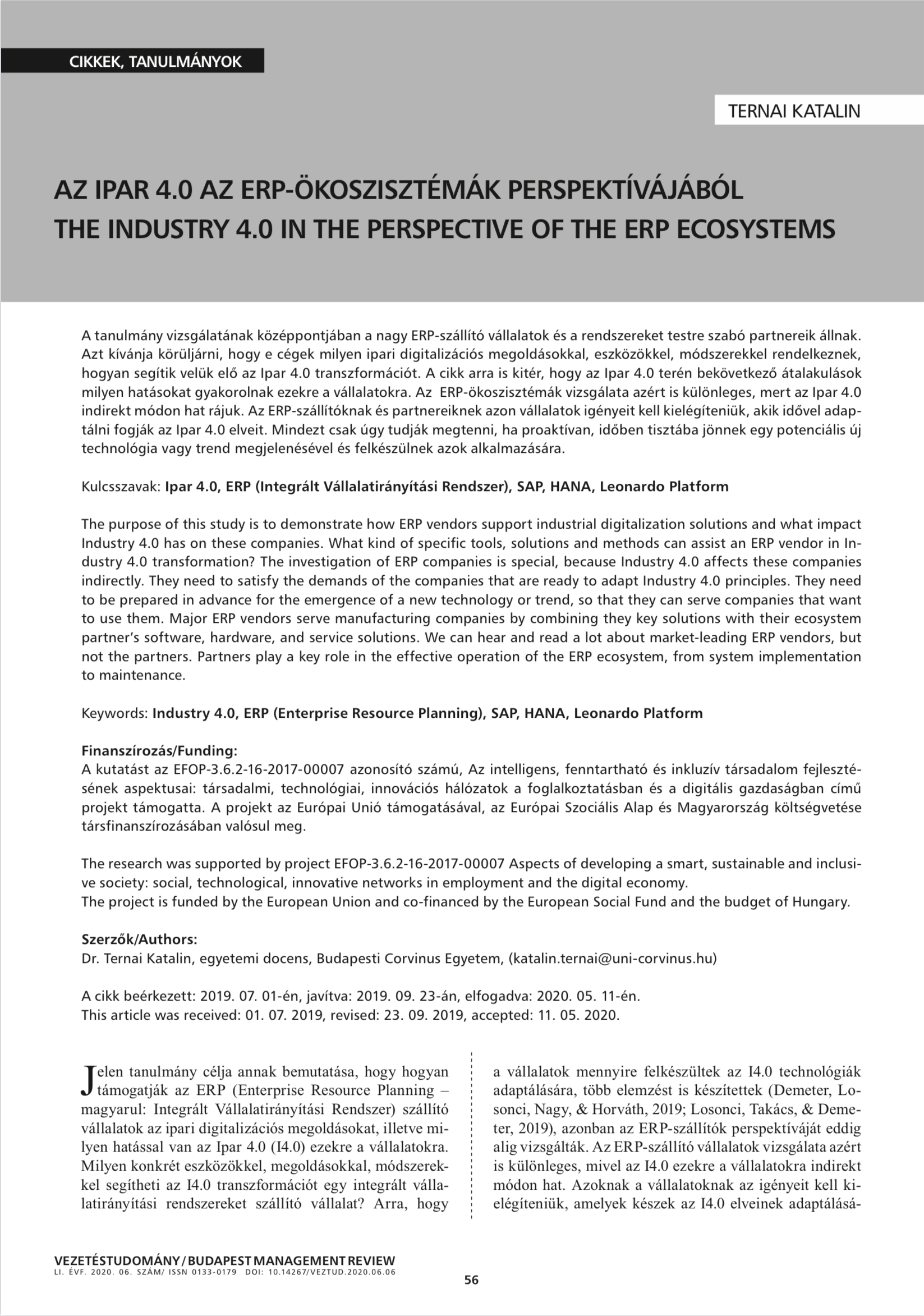Az ipar 4.0 az ERP-ökoszisztémák perspektívájából
DOI:
https://doi.org/10.14267/VEZTUD.2020.06.06Keywords:
Industry, ERP (Enterprise Resource Planning), SAP, HANA, Leonardo PlatformAbstract
The purpose of this study is to demonstrate how ERP vendors support industrial digitalization solutions and what impact Industry 4.0 has on these companies. What kind of specific tools, solutions and methods can assist an ERP vendor in Industry 4.0 transformation? The investigation of ERP companies is special, because Industry 4.0 affects these companies indirectly. They need to satisfy the demands of the companies that are ready to adapt Industry 4.0 principles. They need to be prepared in advance for the emergence of a new technology or trend, so that they can serve companies that want to use them. Major ERP vendors serve manufacturing companies by combining they key solutions with their ecosystem partner’s software, hardware, and service solutions. We can hear and read a lot about market-leading ERP vendors, but not the partners. Partners play a key role in the effective operation of the ERP ecosystem, from system implementation to maintenance.
Downloads
References
Acatech (2013). Securing the future of German manufacturing industry, Recommendations for implementing the strategic initiative INDUSTRIE 4.0. Federal Ministry of Education and Research https://en.acatech.de/publication/recommendationsfor-implementing-the-strategic-initiative-industrie-4-0-final-report-of-the-industrie-4-0-working-group/
Autopro és SAP Hungary (2018). Nagyot kockáztatnak a magyar cégek. Retrieved from https://m2mzona.hu/auto/nagyot-kockaztatnak-a-magyar-cegek/amp
Basl, J. (2017). Pilot Study of Readiness of Czech Companies to Implement the Principles of Industry 4.0. Management and Production Engineering Review, 8(2), 3-8. Retrieved from https://journals.pan.pl/dlibra/show-content?id=106284&
Basl, J. (2016). Enteprise information systems and technologies in Czech companies from the perspective of trends in industry 4.0. Confenis Conference, Wien. https://hal.inria.fr/hal-01630542
Berger, R. (2014). Industry 4.0 The new industrial revolution (How Europe will succeed?) http://www.iberglobal.com/files/Roland_Berger_Industry.pdf
Borbásné Szabó, I. (2018). Informatikai megoldások a digitális transzformáció szolgálatában: SAP Leonardo. Előadás EFOP-3.6.1-16-2016-00013 Intelligens szakosodást szolgáló intézményi fejlesztések a Budapesti Corvinus Egyetem Székesfehérvári Campusán, Székesfehérvár.
Cearley, D., Walker, M., & Andrews, W. (2017). Top 10 Strategic Technology Trends for 2018: Intelligent Apps and Analytics. Gatner, Inc. Retrieved from https://www.gartner.com/doc/3811368?srcId=1-6595640781
CMSC Media (2019). SAP Unveils Blockchain Service n the Cloud. https://www.cms-connected.com/PromoNews/SAP-Debuts-New-Leonardo-Blockchainas-a-Service
Demeter, K, Losonci, D., Nagy, J., & Horváth, B. (2019). Tapasztalatok az Ipar 4.0-val – egy esetalapú elemzés. Vezetéstudomány, 50(4), 11-23. https://doi.org/10.14267/VEZTUD.2019.04.02
Eisert, R. (2014). Sind Mittelständler auf Industrie 4.0 vorbereitet? http://www.wiwo.de/unternehmen/mittelstand/ innovation-readinessindex-sind-mit telstaendler-auf indust r ie-4-0-vorbereitet/10853686.html.
Gilchriest, B. (2018). Design Thinking and Intelligent Technologies | SAP Leonardo, SAP News Center. https://news.sap.com/2018/08/design-thinking-intelligent-technologies.
Haddara, M., & Elragal, A. (2015). The Readiness of ERP Systems for the Factory of the Future. Procedia Computer Science, 64, 721–728. https://doi.org/10.1016/j.procs.2015.08.598
Hermann, M., Pentek, T., & Otto, B. (2016). Design Principles for Industrie 4.0 Scenarios. In 2016 49th Hawaii International Conference on System Sciences (HICSS) (pp. 3928-3937). Koloa, HI. https://doi.org/10.1109/HICSS.2016.488.
IFUA Horváth & Partners (2017). Ipar 4.0 megoldások 2017-ben. https://www.controllingportal.hu/ipar-4-0-megoldasok/
Invitech (2019). Internet of Things technológia. https://www.invitech.hu/iot/technologia
IT Services Hungary (2013). Mi az a „Big Data”? https://www.it-services.hu/hirek/mi-az-a-big-data/
Kenedy, S. (2015). Made in China (2025). Center for Strategic and International Studies. Retrieved from http://csis.org/publication/made-china-2025
Kis E. (2014). A big data előszobája. Computerworld. Retrieved from https://computerworld.hu/uzlet/a-bigdata-eloszobaja-149212.html
Kovács O. (2017). Az ipar 4.0 komplexitása – I. Közgazdasági Szemle, 64(7-8), 823-851. https://doi.org/10.18414/KSZ.2017.7-8.823
KPMG (2016). The factory of the future. Retrieved from https://assets.kpmg/content/dam/kpmg/es/pdf/2017/06/the-factory-of-the-future.pdf
Losonci, D., Takács, O., & Demeter, K. (2019). Az Ipar 4.0 hatásainak nyomában – a magyarországi járműipar elemzése. Közgazdasági Szemle, 66(2), 185-218. https://doi.org/10.18414/KSZ.2019.2.185
MESSE (2019). Retrieved from https://www.hannovermesse.de/en/supporting-program/eventprogram/conferences
Monostori, L. (2014). Cyber-physical production systems: Roots, expectations and R&D challenges. Procedia CIRP, 17, 9-13. https://doi.org/10.1016/j.procir.2014.03.115
Nagy, J. (2019). Az Ipar 4.0 fogalma és kritikus kérdései – vállalati interjúk alapján. Vezetéstudomány, 50(1), 14-26. https://doi.org/10.14267/VEZTUD.2019.01.02
Németi R. & Berczik M. (2015). SAP HANA, mint az innováció záloga (Előadás). Budapest: Simonyi Konferencia.
Porter, M. E., & Heppelmann, J. E. (2014). How Smart, Connected Products are Transforming Competition. Harvard Business Review, 92(11), 64–88. Retrieved from. https://hbr.org/2014/11/how-smart-connectedproducts-are-transforming-competition
PwC (2016). Industry 4.0 – Building the digital enterprise. PriceWaterhouseCoopers LLP. Retrieved from https://www.pwc.com/gx/en/industries/industries-4.0/landing-page/industry-4.0-building-your-digitalenterprise-april-2016.pdf
Rouse, M. (2016). Definition: SAP Analytics Cloud. TechTarget. Retrieved from https://searchsap.techtarget.com/definition/SAP-Cloud-for-Analytics,
Rüßmann, M., Lorenz, M., Gerbert, P., Waldner, M., Justus, J., Engel, P., & Harnisch, M. (2015). Industry 4.0. The Future of Productivity and Growth in Manufacturing. Retrieved from https://www.bcg.com/publications/2015/engineered_products_project_business_industry_4_future_productivity_growth_manufacturing_industries.aspx#chapter2_section7
SAP (2019a). SAP Leonardo Intelligent Technologies. Retrieved from. https://www.sap.com/products/leonardo.html
SAP (2019b). The Intelligent Enterprise. Retrieved from.
https://www.sap.com/products/intelligent-enterprise.html
SAP Help Portal (2019). Installation Guide for SAP Data Hub. Retrieved from https://help.sap.com/doc/922191c241c74d00bcbc3efaa06f8606/2.4.latest/en-US/loio922191c241c74d00bcbc3efaa06f8606.pdf
SAP (2019c). Data Management. Retrieved from. https://www.sap.com/products/technology-platforms/datamanagement.html
SAP (2019d). SAP Data Hub. Retrieved from. https://developers.sap.com/topics/data-hub.html
Szeker V. (2018). ERP vállalatok felkészültsége az Ipar 4.0 támogatására (TDK-dolgozat). BCE. Gazdálkodástudományi kar. Gazdaságinformatika, Budapest.
Szeker V. (2019). Az Ipar 4.0 hatása a magyar iparvállalatokra és az ERP szállító cégekre (Szakdolgozat). BCE. Gazdálkodástudományi kar. Gazdaságinformatika, Budapest.
Ternai K. (2003). Az ERP-rendszerek metamorfózisa. Vezetéstudomány, 34(7-8.), 35-38.
Tulusan, J., & Hidvégi, P. (2017). SAP Leonardo Digital Manufacturing: Important Steps, Partners, Project, Hungary. In Industry 4.0 Workshop, 20th September 2017, Budapest.
Yin, R. K. (2012). Applications of Case Study Research (3rd edition). Thousand Oaks: Sage.
Wang, S., Wan, J., Li, D., & Zhang, C. (2016). Implementing smart factory of industrie 4.0: an outlook. International Journal of Distributed Sensor Networks, 12(1). Retrieved from https://journals.sagepub.com/doi/10.1155/2016/3159805

Downloads
Published
How to Cite
Issue
Section
License
Authors assign copyright to Vezetéstudomány / Budapest Management Review. Authors are responsible for permission to reproduce copyright material from other sources.

